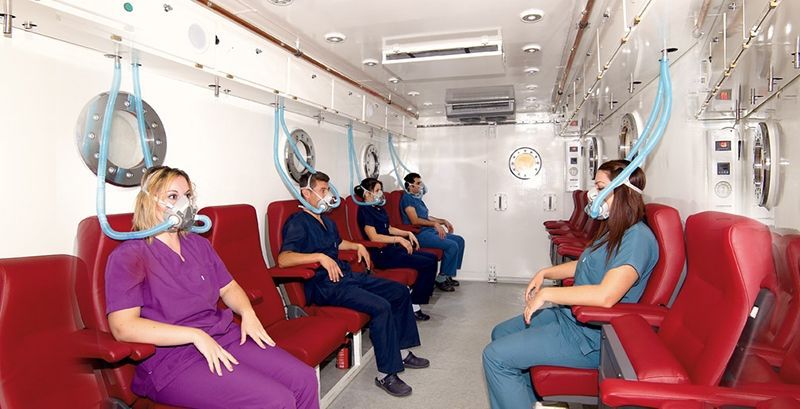Summary | Excerpt | Reading Guide | Discuss | Reviews | Beyond the Book | Read-Alikes | Genres & Themes | Author Bio

This article relates to Miracle Creek
 HBOT (hyperbaric oxygen therapy), the medical treatment at the center of Miracle Creek, is a real treatment used for a variety of conditions. While undergoing HBOT, you breathe pure oxygen in an environment where the air pressure is much higher than normal. The higher pressure allows you to take in more oxygen, which can help your body heal faster from injuries, infections, and other conditions.
HBOT (hyperbaric oxygen therapy), the medical treatment at the center of Miracle Creek, is a real treatment used for a variety of conditions. While undergoing HBOT, you breathe pure oxygen in an environment where the air pressure is much higher than normal. The higher pressure allows you to take in more oxygen, which can help your body heal faster from injuries, infections, and other conditions.
Records suggest that it was a British physician who first applied hyperbaric therapy in 1662. French physician Paul Bert later researched the science behind hyperbaric therapy and, in 1878, published his findings in a book he wrote, entitled La Pression Barométrique. In recent years, medical professionals all over the world have used hyperbaric chambers to treat a variety of conditions.
Doctors may recommend hyperbaric oxygen therapy as a primary treatment for some conditions. Patients, or family members of patients, may opt to try it as an alternative for others. The FDA has approved HBOT for treating 13 conditions including decompression sickness, a condition that can affect scuba divers, and also miners in some conditions.
Various agencies and medical centers have made statements about the limits of HBOT. The FDA has expressed concern about HBOT treatment centers misleading people with inaccurate claims and advises patients to consult their doctors about any treatments for a condition before undergoing them. According to the Mayo Clinic, "the evidence is insufficient to support claims that hyperbaric oxygen therapy can effectively treat" a substantial number of conditions, including cancer, autism, HIV, cerebral palsy, and Alzheimer's.
 While generally considered safe, HBOT does carry some risks. Johns Hopkins lists "rare" possible side effects, some of which are temporary nearsightedness, seizures, low blood sugar, and—interestingly enough—decompression sickness. Due to the flammability of pure oxygen, another risk is fire.
While generally considered safe, HBOT does carry some risks. Johns Hopkins lists "rare" possible side effects, some of which are temporary nearsightedness, seizures, low blood sugar, and—interestingly enough—decompression sickness. Due to the flammability of pure oxygen, another risk is fire.
Although HBOT is frequently used to treat some conditions like autism and cerebral palsy, its effectiveness and even appropriateness is questionable, but this hasn't stopped parents of children with these conditions from trying it. The author of Miracle Creek, Angie Kim, wrote an article for Vogue about her attempt to treat her son's celiac disease and ulcerative colitis with HBOT. She saw an unexpected increase in his hearing function (following a diagnosis of a hearing disorder) and improvement with his digestive issues, as well as some changes in the conditions of other patients attending the HBOT sessions.
Anecdotal stories of success, along with positive results in scientific studies, may very well help HBOT continue to gain attention in years to come. Despite a lack of conclusive evidence, some smaller studies and individual cases suggest HBOT could have potential to treat depression and anxiety, Alzheimer's, and certain types of cancer.
Filed under Medicine, Science and Tech
![]() This "beyond the book article" relates to Miracle Creek. It originally ran in May 2019 and has been updated for the
April 2020 paperback edition.
Go to magazine.
This "beyond the book article" relates to Miracle Creek. It originally ran in May 2019 and has been updated for the
April 2020 paperback edition.
Go to magazine.
In youth we run into difficulties. In old age difficulties run into us
Click Here to find out who said this, as well as discovering other famous literary quotes!
Your guide toexceptional books
BookBrowse seeks out and recommends the best in contemporary fiction and nonfiction—books that not only engage and entertain but also deepen our understanding of ourselves and the world around us.